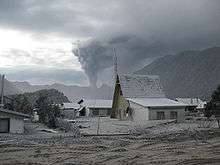Volcanism of Chile
Volcanology of Chile studies a continuous volcanic process that has a strong influence on Chilean landscape, geology, economy and society. Volcanism constantly renews the Chilean landscape with lava flows, lava plateaus, lava domes, cinder cones, stratovolcanoes, shield volcanoes, submarine volcanoes, calderas, diatremes, and maars. However volcanism in Chile as well as in other parts of the world is also associated with several natural hazards such as lahars, earthquakes, pyroclastic flows, toxic gases and ash. Continental Chile has a high concentration of active volcanoes due to its location along the Peru–Chile Trench, a subduction zone where the Nazca and Antarctic Plates are driven beneath the South American Plate. Chile has been subject to volcanism since at least late Paleozoic when subduction along the western margin of South America began. Easter Island, Juan Fernández Islands and other oceanic islands of Chile are extinct volcanoes created by hotspots. Chile has about 500 volcanoes considered active, 60 of which have had recorded eruptions in the last 450 years. The volcanoes with most recorded eruptions are:
- Llaima (8)
- Villarrica (6)
- Antuco Volcano (4)
- Planchón-Peteroa (3)
- Lonquimay (3)
- Calbuco (3)

1.jpg)
External links
- Monitoring the volcanoes of Chile by SERNAGEOMIN, Chile's National Geology and Mining Service